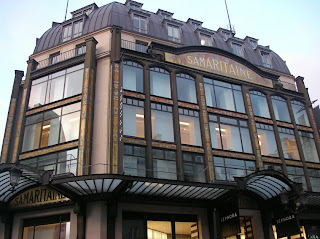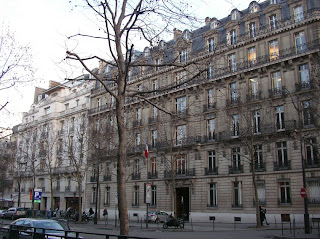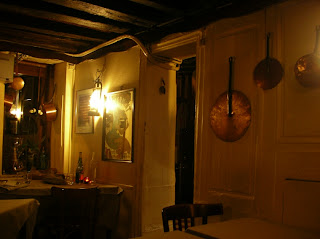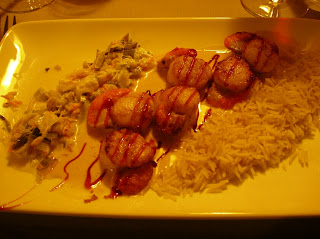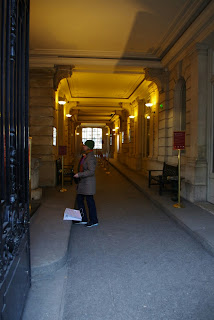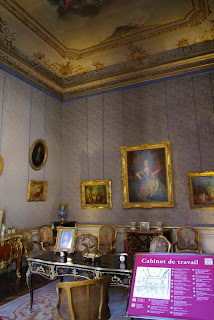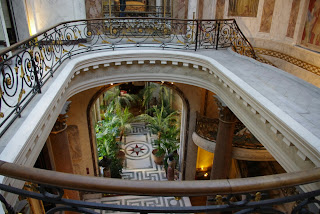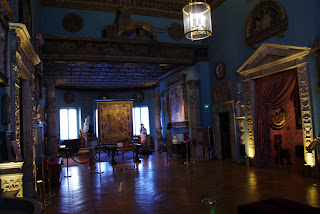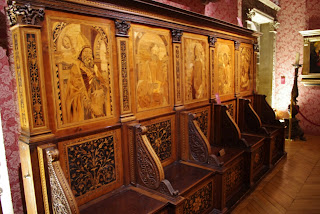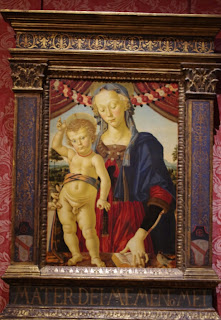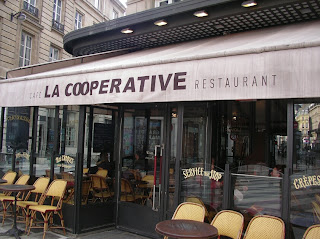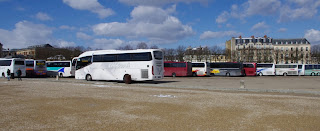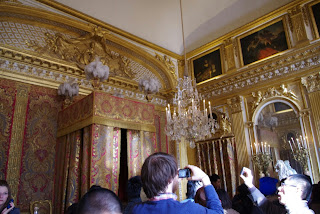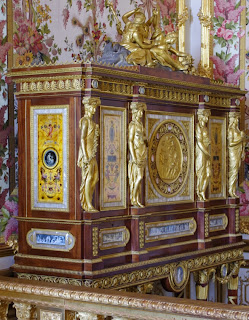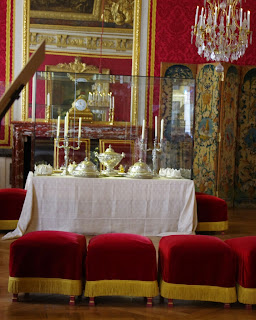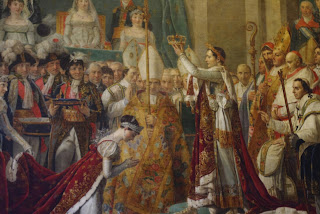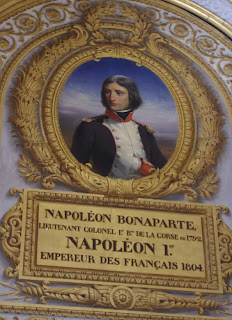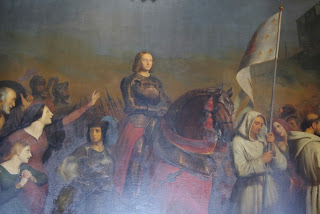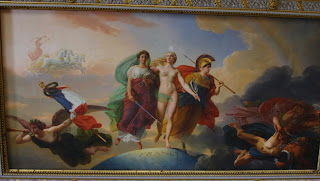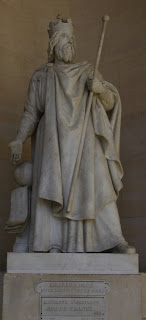Headings
Food
(428)
History
(350)
Travel
(238)
art
(203)
France
(138)
Spain
(130)
Vancouver Island
(123)
maritimes
(119)
UK
(96)
Portugal
(81)
Postcard of the Interwebs
(70)
Musings
(47)
Tofino
(47)
Scandinavia
(44)
book
(37)
Hornby
(29)
Movie and TV
(25)
Conventions
(23)
Music
(19)
Wisdom without Zealotry
(17)
Quadra Island
(12)
San Francisco
(11)
Ottawa
(5)
Sunday 31 March 2013
France - Paris day 06 - La Cordonnerie restaurant
La Cordonnerie is a little restaurant in the 17th district that was one the best if not the best place to eat in Paris.
It has been open since 1964 but the building is much much older than that. 1640's to be more specific. It serves traditional french food.
My wife had fried mushrooms from the Loire valley called Pleurote.
I had the tuna tartare.
My wife then had Coquille St Jacques (scallops) in butter creme sauce.
I had the enchine de porc (pork rib meat with scalloped potatoes).
For dessert we had the apple tartin and we walked away after closing the place for the night. Fantastic.
It has been open since 1964 but the building is much much older than that. 1640's to be more specific. It serves traditional french food.
My wife had fried mushrooms from the Loire valley called Pleurote.
I had the tuna tartare.
My wife then had Coquille St Jacques (scallops) in butter creme sauce.
I had the enchine de porc (pork rib meat with scalloped potatoes).
For dessert we had the apple tartin and we walked away after closing the place for the night. Fantastic.
Location:
20 Rue Saint-Roch, 75001 Paris, France
France - Paris day 06 - Arc de Triomphe
The Arc de Triomphe (de l'Étoile) was designed in 1806, after Napoleon's victory at Austerlitz and completed in 1836.It is 50 meters in height.
It is covered by statuary of heroic nude Frenchmen battling bearded and mustached Germans.
On the inside arch it has battles France has participated in.
After the long climb to the top (included in the museum pass plus you skip lines), it has spectacular 360 degree views. Try to go a half hour prior to sunset for the best transition views from light to dark.
The Arch of Defense to the North West is seen here.
Another famous landmark...what was its name?
The eternal flame for the unknown soldier burns beneath it.
It looks quite nice at night.
It is covered by statuary of heroic nude Frenchmen battling bearded and mustached Germans.
On the inside arch it has battles France has participated in.
After the long climb to the top (included in the museum pass plus you skip lines), it has spectacular 360 degree views. Try to go a half hour prior to sunset for the best transition views from light to dark.
The Arch of Defense to the North West is seen here.
Another famous landmark...what was its name?
The eternal flame for the unknown soldier burns beneath it.
It looks quite nice at night.
France - Paris day 06 - Jacquemart-Andre Mansion and Museum
The Jacquemart-Andre mansion and museum is a fantastic place to see. Its near the Arc de Triomphe.
It was originally built in 1875 and house the art collected by him and his wife during their yearly trips to Italy. She was a popular painter of persons of Paris society.
The house has two driveways into it which travel under one wing or the other. That way you could have continuous traffic.
Here is the back of the house.
Thier rooms are left just about as they were when Mrs Jacquemart died in 1913. They are lavish and tasteful.
The staircase was done by the runner up of the staircase for the Paris Opera house. It is also built so that people going up and down only meet at the top and the first part of the bottom.
This is the upper area of the music room and is the start of their special collections.
This is one of two rooms with glorious artwork collected by these two persons.
Saint George defeating a dragon. In most art and sculpture the dragon is no bigger than George's thigh but here it is the size of his horse. Done by Paolo Uccello in 1440.
Wonderfully inlaid wood church benches.
Done by La Peruguin in 1470
It is magnificent to see these items that were collected by these two. They only brought special friends to see the items in these two rooms.
A Botticelli done in 1505.
There is a self portrait of Nelie Jacquemart on the left.
It was originally built in 1875 and house the art collected by him and his wife during their yearly trips to Italy. She was a popular painter of persons of Paris society.
The house has two driveways into it which travel under one wing or the other. That way you could have continuous traffic.
Here is the back of the house.
Thier rooms are left just about as they were when Mrs Jacquemart died in 1913. They are lavish and tasteful.
The staircase was done by the runner up of the staircase for the Paris Opera house. It is also built so that people going up and down only meet at the top and the first part of the bottom.
This is the upper area of the music room and is the start of their special collections.
This is one of two rooms with glorious artwork collected by these two persons.
Saint George defeating a dragon. In most art and sculpture the dragon is no bigger than George's thigh but here it is the size of his horse. Done by Paolo Uccello in 1440.
Wonderfully inlaid wood church benches.
Done by La Peruguin in 1470
It is magnificent to see these items that were collected by these two. They only brought special friends to see the items in these two rooms.
A Botticelli done in 1505.
There is a self portrait of Nelie Jacquemart on the left.
France - Paris day 06 - La Cooperative
La Cooperative is a fantastic bistro just a few blocks East from the Louvre.
Its wines and foods are fantastic, service is excellent and setting very classic.
This is their mixed meat and cheese plate and was around twelve euros as I recall.
Its wines and foods are fantastic, service is excellent and setting very classic.
This is their mixed meat and cheese plate and was around twelve euros as I recall.
Location:
85 Rue de Rivoli, 75001 Paris, France
France - Paris day 06 - Palace of Versailles - Part 3 of 3
The grounds out back are also huge and by huge I mean 800 hectares. It was closed due to snow the morning we were there but it was open after lunch. But after spending almost four hours inside we were Versailled out. We decided on a short hour long walk outside.
A view behind the palace. They were fixing up the fountain while we were there. The water out back is available to boat around in during warmer months.
This is the Latona fountain.
The hedgerows were particularly well cut.
Another excellent water sculpture, this time with Neptune and his horses. If you carry on to the right of him, you get to the Trianon, little Trianon and Marie Antoinette's little farming village she made to feel more down to earth. The Trianon's are regarded as one of the finest examples of modern architecture of a classical vein. It is open to the public but has been used to house guests of the French state even today. It was originally built as a retreat for King Louis the fourteenth and his official state mistress.
The grove of the colonnade, built in 1685.
There are many cats in the gardens.
Another statue.
By the way, this is March and I could not get all the tour buses in the picture. Get there early! If traveling from Paris, take an early suburban train and have breakfast at the Ibis hotel. Its cheap and all you can eat with lots of nice items.
A view behind the palace. They were fixing up the fountain while we were there. The water out back is available to boat around in during warmer months.
This is the Latona fountain.
The hedgerows were particularly well cut.
Another excellent water sculpture, this time with Neptune and his horses. If you carry on to the right of him, you get to the Trianon, little Trianon and Marie Antoinette's little farming village she made to feel more down to earth. The Trianon's are regarded as one of the finest examples of modern architecture of a classical vein. It is open to the public but has been used to house guests of the French state even today. It was originally built as a retreat for King Louis the fourteenth and his official state mistress.
The grove of the colonnade, built in 1685.
There are many cats in the gardens.
Another statue.
By the way, this is March and I could not get all the tour buses in the picture. Get there early! If traveling from Paris, take an early suburban train and have breakfast at the Ibis hotel. Its cheap and all you can eat with lots of nice items.
France - Paris day 06 - Palace of Versailles - Part 2 of 3
Another incredible ceiling at Versailles.
This was King Louis the fourteenths bedroom but became working rooms for successive rulers.
The statuary around the painting are...not conducive to sleeping.
This is the council room, where business of state and the swearing in of special appointments were done.
Marie Antoinette's apartment.
Her little dresser is a little modest, n'est ce pas?
The dining room where lucky and loyal persons could watch the King and Queen eat on comfy cushion chairs. I'm not kidding. It was, in the King's mind, so that the common folk could see that the royal family were human.
A painting in the "war room".
A copy of the famous painting, "the crowning of the empress Josephine by the Emperor Napoleon the first in Nortre Dame of Paris on 2 December 1804" made 1808-1822. This copy is as big as the original which is in the Louvre. Both are over six meters by nine meters in size.
This is a room with portraits of many of the revolutionary persons of note, after they took over the place.
It includes this fellow.
This staircase was in the wing where the dauphin (young Prince) stayed at. I'm shocked that they thought the balcony for the stairs was not too low. Very unsafe.
In a very large room were very large paintings, done after Louis-Phillipe was King in 1830. He was the last King of France but the last Monarch was Napoleon the third who took power after him as Emperor. Louis-Phillipe wanted a room with paintings of famous French victories. The one above, if you haven't guessed, is of Joan of Arc's victory at Orleans in 1429.
A painting in the vein of propaganda for King Louis-Phillipe. It is called "Truth accompanying Justice and Wisdom protecting France from Hypocrisy, Fanaticism and Discord".
In the hall of statues, there are many important French persons sculpted here. Jean-François Champollion, translator of the Rosetta Stone in 1822, began modern Egyptology.
Voltaire, or François-Marie Arouet, was a historian and writer in the age of enlightenment.
Blanche of Castile was Spanish born and was Queen to King Louis the eighth and acted as regent twice during her son's reign (Louis the ninth). She was a peacemaker and politically savvy.
Charlemagne. First ruler of France (774-814), warmaker and peace maker too.
Now we are done with the inside. Time for the gardens.
This was King Louis the fourteenths bedroom but became working rooms for successive rulers.
The statuary around the painting are...not conducive to sleeping.
This is the council room, where business of state and the swearing in of special appointments were done.
Marie Antoinette's apartment.
Her little dresser is a little modest, n'est ce pas?
The dining room where lucky and loyal persons could watch the King and Queen eat on comfy cushion chairs. I'm not kidding. It was, in the King's mind, so that the common folk could see that the royal family were human.
A painting in the "war room".
A copy of the famous painting, "the crowning of the empress Josephine by the Emperor Napoleon the first in Nortre Dame of Paris on 2 December 1804" made 1808-1822. This copy is as big as the original which is in the Louvre. Both are over six meters by nine meters in size.
This is a room with portraits of many of the revolutionary persons of note, after they took over the place.
It includes this fellow.
This staircase was in the wing where the dauphin (young Prince) stayed at. I'm shocked that they thought the balcony for the stairs was not too low. Very unsafe.
In a very large room were very large paintings, done after Louis-Phillipe was King in 1830. He was the last King of France but the last Monarch was Napoleon the third who took power after him as Emperor. Louis-Phillipe wanted a room with paintings of famous French victories. The one above, if you haven't guessed, is of Joan of Arc's victory at Orleans in 1429.
A painting in the vein of propaganda for King Louis-Phillipe. It is called "Truth accompanying Justice and Wisdom protecting France from Hypocrisy, Fanaticism and Discord".
In the hall of statues, there are many important French persons sculpted here. Jean-François Champollion, translator of the Rosetta Stone in 1822, began modern Egyptology.
Voltaire, or François-Marie Arouet, was a historian and writer in the age of enlightenment.
Blanche of Castile was Spanish born and was Queen to King Louis the eighth and acted as regent twice during her son's reign (Louis the ninth). She was a peacemaker and politically savvy.
Charlemagne. First ruler of France (774-814), warmaker and peace maker too.
Now we are done with the inside. Time for the gardens.
Location:
Versailles, France
Subscribe to:
Posts (Atom)
